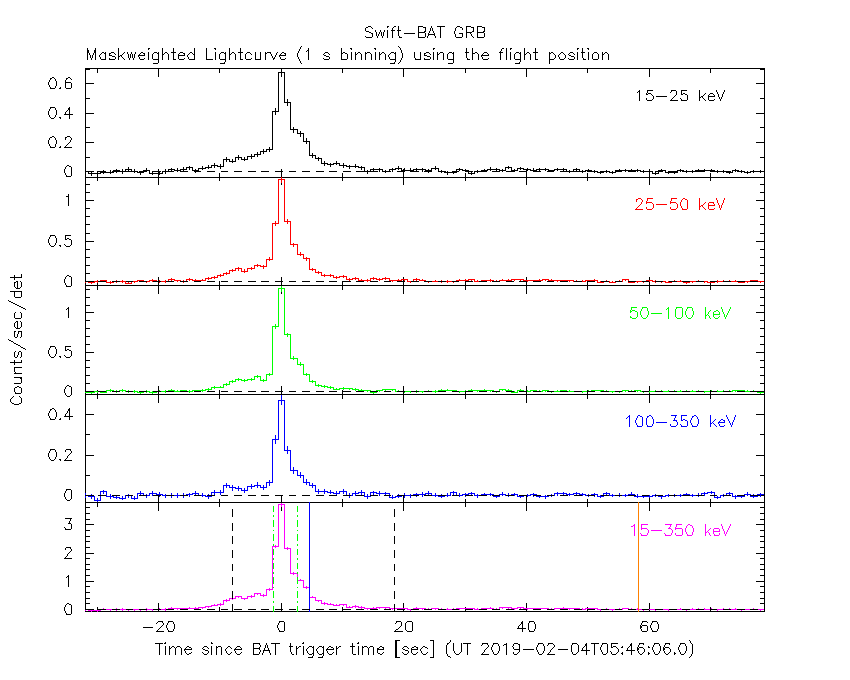
A.Y. Lien (GSFC/UMBC), J.A. Kennea (PSU) and P. Kuin (UCL/MSSL) for the Swift team
At 05:46:01 UT, the Swift Burst Alert Telescope (BAT) triggered and located GRB 190204A (trigger=887579 and 887580) (Lien et al. GCN Circ. 23852). Swift slewed immediately to the burst. At the time of the trigger, the initial BAT position was 77° from the Sun (2.3 hours East) and 82° from the 0%-illuminated Moon. Table 1 contains the best reported positions from Swift, and the latest XRT position can be viewed at http://www.swift.ac.uk/xrt_positions.
Lien et al. (GCN Circ. 23852) reported the discovery with UVOT of an optical afterglow. Table 2 is a summary of GCN Circulars about this GRB from observatories other than Swift.
Standard analysis products for this burst are available at https://gcn.gsfc.nasa.gov/swift_gnd_ana.html.
Analysis of the BAT data was reported by Sakamoto et al. (GCN Circ. 23872).
In this circular, we adopted the trigger time from the first trigger (#887579), 2019-02-04 05:46:01 UT, to be consistent with the T0 quoted in other circulars.
The BAT ground-calculated position is RA, Dec = 351.491, 54.884 deg which is RA(J2000) = 2
The mask-weighted light curve (Figure 1) shows several overlapping pulses that starts at ~T-7 s and ends at ~T+55 s.
The main peak occurs at ~T+5 s.
The time-averaged spectrum from T-6.93 to T+53.82 s is best fit by a simple power-law model.
The power law index of the time-averaged spectrum is 1.30 ± 0.04.
The fluence in the 15-150 keV band is 1.3 ± 0.03 x 1
The results of the batgrbproduct analysis are available at https://gcn.gsfc.nasa.gov/notices_s/887580/BA/.
Analysis of the initial XRT data was reported by Kennea et al. (GCN Circ. 23857). We have analysed 6.4 ks of XRT data for GRB 190204A, from 81 s to 13.0 ks after the BAT trigger. The data comprise 926 s in Windowed Timing (WT) mode with the remainder in Photon Counting (PC) mode.
The late-time light curve (Figure 2) (from T0+4.8 ks) can be modelled with a power-law decay with a decay index of α=1.36 ± 0.16.
A spectrum formed from the WT mode data can be fitted with an absorbed
power-law with a photon spectral index of 1.740 (+0.022, -0.018). The
best-fitting absorption column is consistent with the Galactic value
of 4.4 x 1
The Swift/UVOT began settled observations of the field of GRB 190204A 84 s after the BAT trigger
(Kuin and Lien GCN Circ. 23863).
The updated UVOT position is:
Table 3 gives preliminary
magnitudes using the UVOT photometric system
(Breeveld et al. 2011, AIP Conf. Proc., 1358, 373).
No correction has been made for the expected extinction in the Milky Way
corresponding to a reddening of

Figure 1. The BAT
mask-weighted light curve in the four individual and total
energy bands. The units are counts
| RA (J2000) | Dec (J2000) | Error | Note | Reference |
|---|---|---|---|---|
| 2 |
+54°52'35.1" | 0.4" | UVOT-refined | Kuin and Lien GCN Circ. 23863 |
| 2 |
+54°52'34.9" | 1.5" | XRT-enhanced | Osborne et al. GCN Circ. 23862 |
| 2 |
+54°53'02.4" | 1.0' | BAT-refined | Sakamoto et al. GCN Circ. 23872 |
| Band | Authors | GCN Circ. | Subject | Observatory | Notes |
|---|---|---|---|---|---|
| Optical | Watson et al. | 23861 | COATLI Optical Detection of the Fading Afterglow |
COATLI | detection |
| Optical | Volnova et al. | 23867 | Mondy optical upper limit | Mondy | upper limits |
| Optical | Moskvitin | 23868 | SAO RAS optical observations | SAO RAS | detection |
| X-ray | Oeda et al. | 23854 | MAXI/GSC detection | MAXI | detection |
| Gamma-ray | Khanam et al. | 23856 | AstroSat CZTI detection | CZTI | |
| Gamma-ray | Kozlova et al. | 23869 | Konus-Wind observation | Konus-Wind | Duration=~49 seconds Fluence=5.31(-0.51,+0.53)x1 |
| Gamma-ray | Ito et al. | 23877 | CALET Gamma-Ray Burst Monitor detection | CALET |
| Filter | Exp(s) | Mag | ||
|---|---|---|---|---|
| white | 84 | 233 | 147 | 16.84 ± 0.07 |
| white | 576 | 596 | 20 | 18.66 ± 0.20 |
| v | 626 | 1247 | 78 | 18.30 ± 0.23 |
| b | 551 | 1507 | 85 | 19.29 ± 0.21 |
| u | 296 | 546 | 246 | 17.85 ± 0.10 |
| w1 | 676 | 1470 | 97 | >18.3 |
| m2 | 651 | 1444 | 97 | >19.5 |
| w2 | 602 | 1395 | 97 | >18.7 |
Table 3. UVOT observations reported by Kuin and Lien (GCN Circ. 23863). The start and stop times of the exposures are given in seconds since the BAT trigger. The preliminary detections and 3-σ upper limits are given. No correction has been made for extinction in the Milky Way.
February 7, 2019